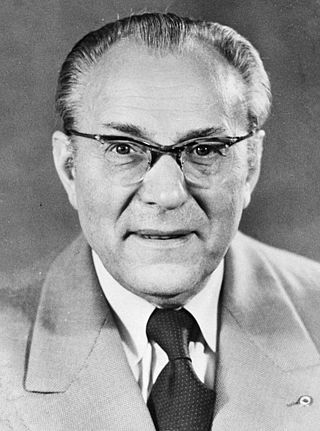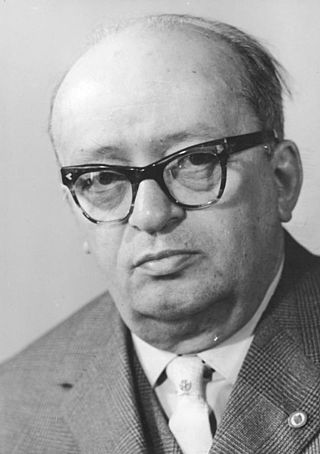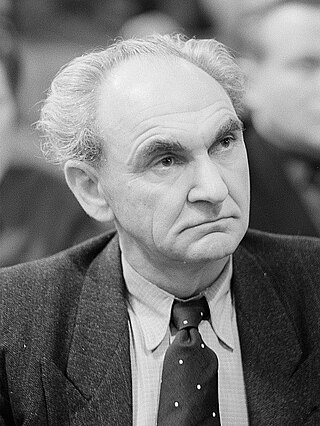
Walter Ernst Paul Ulbricht was a German communist politician. Ulbricht played a leading role in the creation of the Weimar-era Communist Party of Germany (KPD) and later in the early development and establishment of the German Democratic Republic. As the First Secretary of the Socialist Unity Party from 1950 to 1971, he was the chief decision-maker in East Germany. From President Wilhelm Pieck's death in 1960 on, he was also the East German head of state until his own death in 1973. As the leader of a significant Communist satellite, Ulbricht had a degree of bargaining power with the Kremlin that he used effectively. For example, he demanded the building of the Berlin Wall in 1961 when the Kremlin was reluctant.

The Socialist Unity Party of Germany was the founding and ruling party of the German Democratic Republic from the country's foundation in 1949 until its dissolution after the Peaceful Revolution in 1989. It was a Marxist–Leninist communist party, established in 1946 as a merger of the East German branches of the Communist Party of Germany and Social Democratic Party of Germany.

The East German uprising of 1953 was an uprising that occurred in the German Democratic Republic from 16 to 17 June 1953. It began with strike action by construction workers in East Berlin on 16 June against work quotas during the Sovietization process in East Germany. Demonstrations in East Berlin turned into a widespread uprising against the Government of East Germany and the ruling Socialist Unity Party the next day, involving over one million people in about 700 localities across the country. Protests against declining living standards and unpopular Sovietization policies led to a wave of strikes and protests that were not easily brought under control and threatened to overthrow the East German government. The uprising in East Berlin was violently suppressed by tanks of the Soviet forces in Germany and the Kasernierte Volkspolizei. Demonstrations continued in over 500 towns and villages for several more days before eventually dying out.

The Baltic Sea island of Vilm lies in the bay south of the much larger island of Rügen, and is one of Germany's most remote and tranquil spots. Covering less than 1 square kilometre (0.39 sq mi), Vilm is the remnant of a moraine left as the glaciers retreated about 6000 years ago. Since its formation the shape of the island has gradually changed, with sandbars and beaches forming and eroding continuously. Today the island is shaped like a 2.5-kilometre-long (1.6 mi) tadpole, consisting of two distinct parts. Great Vilm, the "head" to the north-east, rises to almost 40 metres (130 ft). The low-lying isthmus of Middle Vilm forms a long "tail" to the south-west, which culminates in Little Vilm, a rocky mound about 20 metres (66 ft) above sea level. The chalky cliffs to the southern side of Great Vilm are rapidly eroding, while sandbanks are building to add a snail-like curl to the tail.

Otto Emil Franz Grotewohl was a German politician who served as the first prime minister of the German Democratic Republic from its foundation in October 1949 until his death in September 1964.

Friedrich "Fritz" Ebert Jr. was a German socialist and later communist politician, the son of Germany's first president Friedrich Ebert. He was originally a Social Democrat like his father before him, but is best known for his role in the foundation of East Germany's ruling party, the Socialist Unity Party of Germany, in which he served in various positions.

Ernst Friedrich Wollweber was a German politician who was State Secretary of State Security from 1953 to 1955 and Minister of State Security of East Germany from 1955 to 1957.

Wilhelmstraße, or Wilhelmstrasse is a major thoroughfare in the central Mitte and Kreuzberg districts of Berlin, Germany. Until 1945, it was recognised as the centre of the government, first of the Kingdom of Prussia, and later of the unified German Reich, housing in particular the Reich Chancellery and the Foreign Office. The street's name was thus also frequently used as a metonym for overall German governmental administration: much as the term "Whitehall" is often used to signify the British governmental administration as a whole. In English, "the Wilhelmstrasse" usually referred to the German Foreign Office.

Schönhausen Palace is a Baroque palace at Niederschönhausen, in the borough of Pankow, Berlin, Germany. It is surrounded by gardens through which the Panke river runs. The palace is maintained by the Prussian Palaces and Gardens Foundation Berlin-Brandenburg and reopened to the public in 2009 after extensive restoration.
The New Economic System, officially the New Economic System of Planning and Management, was an economic policy that was implemented by the ruling Socialist Unity Party (SED) of the German Democratic Republic (GDR) in 1963. Its purpose was to replace the system of Five-Year Plans which had been used to run the GDR's economy from 1951 onwards. The System was introduced by Walter Ulbricht to try to improve the performance of the existing central planning, so that the economy might be run in as efficient a manner as possible.

Waldsiedlung was the secure housing zone for the leaders of the German Democratic Republic in Bernau bei Berlin, Brandenburg from 1960 to 1989. Waldsiedlung housed the most senior party members of the ruling Socialist Unity Party of Germany (SED) in relative luxury near Wandlitz, 30 kilometres (19 mi) north of East Berlin, with surrounding areas off-limits to all ordinary citizens.

The Ulbricht Group was a group of exiled members of the Communist Party of Germany and the National Committee for a Free Germany, led by Walter Ulbricht, who flew from the Soviet Union back to Germany on April 30, 1945. Composed of functionaries from the KPD and ten anti-fascist prisoners of war, their job was to seek out anti-fascist individuals and prepare the groundwork for the re-establishment of communist organizations and unions in postwar Berlin. There were two additional regional groups, the Ackermann Group in Saxony and the Sobottka Group in Mecklenburg. Many of the group's members later became high-level officials in the government of the German Democratic Republic (GDR).

Charlotte "Lotte" Ulbricht was a Socialist Unity Party of Germany (SED) official and the second wife of the East German leader Walter Ulbricht.

Heinrich Gottlob "Heiner" Rau was a German communist politician during the time of the Weimar Republic; subsequently, during the Spanish Civil War, he was a leading member of the International Brigades and after World War II a leading East German statesman.

"Sonderzug nach Pankow" is a song by the German rock singer Udo Lindenberg, released as a single on 2 February 1983. It was a reaction to the refusal of the West German singer's wish to perform a concert in East Germany by the East German administration in charge. The song's lyrics refer directly to East German leader Erich Honecker, who took offense to the song. The melody is based on the 1941 swing classic "Chattanooga Choo Choo" by Glenn Miller.

Rudolf Herrnstadt was a German journalist and communist politician. After abandoning his law studies in 1922, Herrnstadt became a convinced communist. Despite his bourgeois origins, he was accepted into the Communist Party of Germany (KPD) in 1931 and worked for the Soviet military intelligence service Glawnoje Raswedywatelnoje Uprawlenije. As a foreign correspondent for the Berliner Tageblatt, he worked in Prague (1930), Warsaw and Moscow (1933). He emigrated to the Soviet Union in 1939, days before the Invasion of Poland, where he was active in the fight against the Nazi state as editor-in-chief of the newspaper Freies Deutschland in the National Committee for a Free Germany from 1944 during the German-Soviet War.

Niederschönhausen is a locality (Ortsteil) within the borough (Bezirk) of Pankow in Berlin, Germany. It is also known as "Pankow-Schönhausen" to differ it from Hohenschönhausen in Berlin-Lichtenberg. From 1949 until 1960 Schönhausen Palace and the adjacent Majakowskiring quarter were the residence of several members of the East German government, commonly referred to as Pankow by the West German media.

Throughout their existence East Germany and the Soviet Union maintained close diplomatic relations. The Soviet Union was the chief economic and political sponsor of East Germany.

Dietrich Karl Nummert was a German journalist and author.
Beate Ulbricht, also known as Beate Matteoli, was the adopted daughter of First Secretary of the Socialist Unity Party of the GDR Walter Ulbricht and his wife Lotte.


















